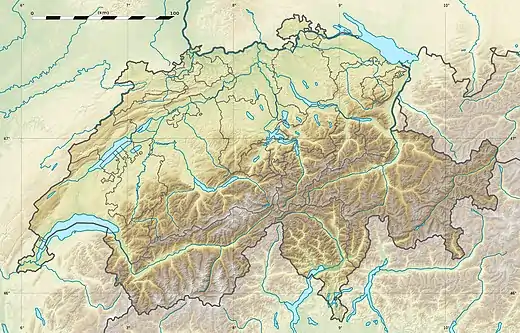Napf
The Napf is a mountain on the border between the Swiss cantons of Bern and Lucerne. With an altitude of 1,408 meters (4,619 ft), it is the summit of the Napfgebiet (Napf region), the hilly region lying between Bern and Lucerne.[3] It is counted geologically as part of the Swiss plateau, although it is sometimes considered part of the Emmental Alps.[4] The region is bounded by the Emmental to the south-west and the Entlebuch to the east. The region is traversed by the Brünig-Napf-Reuss line.
| Napf | |
|---|---|
 The summit | |
| Highest point | |
| Elevation | 1,408 m (4,619 ft) |
| Prominence | 552 m (1,811 ft)[1] |
| Isolation | 10.5 km (6.5 mi)[2] |
| Coordinates | 47°0′15″N 7°56′24″E |
| Geography | |
 Napf Location in Switzerland | |
| Location | Bern/Lucerne, Switzerland |
| Parent range | Napfgebiet, Emmental Alps |
The peak is surrounded by steep hills that are a patchwork of evergreen forests and small mountain farms. Nearby towns include Romoos, Doppleschwand, Michlischwand, Luthern, and Menzberg.
Climate
| Climate data for Napf: 1403m (1991–2020) | |||||||||||||
|---|---|---|---|---|---|---|---|---|---|---|---|---|---|
| Month | Jan | Feb | Mar | Apr | May | Jun | Jul | Aug | Sep | Oct | Nov | Dec | Year |
| Average high °C (°F) | 1.3 (34.3) |
1.0 (33.8) |
3.8 (38.8) |
7.7 (45.9) |
12.1 (53.8) |
15.9 (60.6) |
18.0 (64.4) |
17.6 (63.7) |
13.1 (55.6) |
9.7 (49.5) |
4.8 (40.6) |
2.2 (36.0) |
8.9 (48.0) |
| Daily mean °C (°F) | −1.3 (29.7) |
−1.6 (29.1) |
1.0 (33.8) |
4.2 (39.6) |
8.3 (46.9) |
11.9 (53.4) |
13.9 (57.0) |
13.9 (57.0) |
10.0 (50.0) |
6.8 (44.2) |
2.2 (36.0) |
−0.4 (31.3) |
5.7 (42.3) |
| Average low °C (°F) | −3.8 (25.2) |
−4.1 (24.6) |
−1.7 (28.9) |
1.2 (34.2) |
5.0 (41.0) |
8.6 (47.5) |
10.6 (51.1) |
10.9 (51.6) |
7.4 (45.3) |
4.3 (39.7) |
−0.1 (31.8) |
−2.8 (27.0) |
3.0 (37.4) |
| Average precipitation mm (inches) | 98 (3.9) |
98 (3.9) |
114 (4.5) |
126 (5.0) |
188 (7.4) |
178 (7.0) |
188 (7.4) |
176 (6.9) |
131 (5.2) |
118 (4.6) |
110 (4.3) |
124 (4.9) |
1,649 (64.9) |
| Average precipitation days (≥ 1.0 mm) | 11.1 | 10.8 | 12.5 | 12.6 | 15.1 | 13.8 | 13.4 | 12.8 | 11.2 | 11.9 | 11.4 | 12.7 | 149.3 |
| Average relative humidity (%) | 74 | 76 | 78 | 77 | 80 | 80 | 78 | 79 | 84 | 80 | 77 | 75 | 78 |
| Mean monthly sunshine hours | 101 | 103 | 136 | 150 | 153 | 173 | 190 | 185 | 148 | 129 | 94 | 84 | 1,648 |
| Percent possible sunshine | 38 | 37 | 38 | 38 | 35 | 38 | 42 | 44 | 41 | 40 | 35 | 33 | 39 |
| Source: MeteoSwiss[5] | |||||||||||||
References
- Retrieved from the Swisstopo topographic maps. The key col is located near Escholzmatt at 856 metres.
- Retrieved from Google Earth. The nearest point of higher elevation is northeast of the Beichle.
- "Napfgebiet". Retrieved 18 June 2010.
- The eastern half of the massif is part of the Alpine Convention perimeter.
- "Climate Normals Napf (Reference period 1991−2020)" (PDF). Swiss Federal Office of Meteorology and Climatology, MeteoSwiss. Retrieved 29 January 2022.
This article is issued from Wikipedia. The text is licensed under Creative Commons - Attribution - Sharealike. Additional terms may apply for the media files.